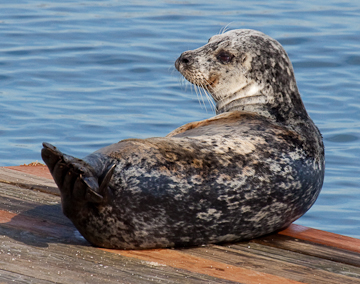Feb 2010
Seal rests onshore today
Feb/27/10 03:40 PM


"Sailing" sea lion sparks concern
Feb/21/10 07:55 PM
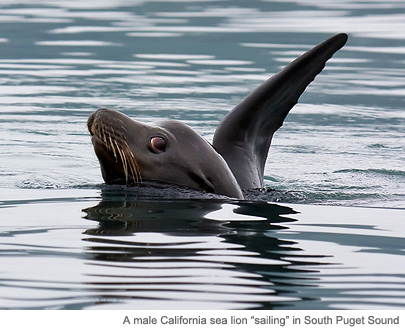
So, what exactly is thermoregulation? Sea lions and other pinnipeds have a system of veins and arteries that transfer heat to the rest of their bodies and organs. By extending their flippers out of the water, the blood in that less insulated part of the body absorbs heat from the sun or warmer air, and circulates it through the body to their internal organs. Conversely, on a hot day, you may see a sea lion with flippers to the wind, cooling the blood which then circulates and reduces body temperature. Read more about sea lions on our website.
Necropsies in progress
Feb/21/10 06:22 PM
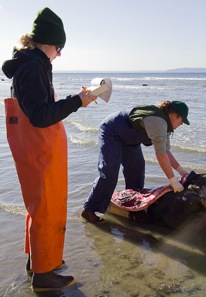
More necropsies to be performed by WDFW
Feb/16/10 11:42 AM
Washington Dept. of Fish and Wildlife (WDFW) plans to respond and necropsy an additional four California sea lions to investigate cause of death. Please check back for updates when available.
Authorities from NOAA and WDFW would like to stress that it is extremely difficult to tell upon a visual examination if a marine mammal has been shot. A bullet entry wound is quite small and particularly difficult to see on a fur-covered animal, much less one that has been dead in the water or on shore for some time; fur tends to rub off in circular spots and scavengers (both marine and terrestrial) can create wounds that might appear to the layperson as a bullet wound. Indeed, the biologists have to search quite extensively through blubber layers, muscle and tissue to find signs of bullet entry and hemmoraging in hopes of retrieving a bullet. Often, it can only be determined by radiography. So, if you find a dead seal or sea lion, please do not assume the animal has been shot. Report it immediately to NOAA’s hotline 1-800-853-1964 or in West Seattle, call Seal Sitters dispatch @ 206-905-7325 (SEAL).
Authorities from NOAA and WDFW would like to stress that it is extremely difficult to tell upon a visual examination if a marine mammal has been shot. A bullet entry wound is quite small and particularly difficult to see on a fur-covered animal, much less one that has been dead in the water or on shore for some time; fur tends to rub off in circular spots and scavengers (both marine and terrestrial) can create wounds that might appear to the layperson as a bullet wound. Indeed, the biologists have to search quite extensively through blubber layers, muscle and tissue to find signs of bullet entry and hemmoraging in hopes of retrieving a bullet. Often, it can only be determined by radiography. So, if you find a dead seal or sea lion, please do not assume the animal has been shot. Report it immediately to NOAA’s hotline 1-800-853-1964 or in West Seattle, call Seal Sitters dispatch @ 206-905-7325 (SEAL).
News media reports of 5 shot sea lions in WS inaccurate
Feb/13/10 10:09 AM
Published reports by the news media that 5 sea lions have been found shot on West Seattle beaches are erroneous. In fact, three sea lions (1 Steller and 2 California sea lions) dead from gunshot wounds have washed up on our shore. The other two shot sea lions were found in Burien and Gig Harbor. As sometimes can happen when a news story is fast breaking, information can get misconstrued.
According to DFW, there are an estimated 3-9 additional sea lions floating in the water. This number is vague due to the fact that the same sea lion may be sighted over and over in different locations. This stresses the need for a dead animal onshore to be reported immediately so that authorities can mark and secure the animal for possible necropsy. Seal Sitters reminds you that when reporting any marine mammal onshore (dead or alive) give as precise a location as possible in a timely manner.
According to DFW, there are an estimated 3-9 additional sea lions floating in the water. This number is vague due to the fact that the same sea lion may be sighted over and over in different locations. This stresses the need for a dead animal onshore to be reported immediately so that authorities can mark and secure the animal for possible necropsy. Seal Sitters reminds you that when reporting any marine mammal onshore (dead or alive) give as precise a location as possible in a timely manner.
Canadian seal "hunt" to begin this week
Feb/13/10 06:54 AM
The annual Canadian seal hunt is scheduled to begin this week. For news updates regarding this barbaric practice, please visit the Breaking News section on Seal Sitters’ website.
To join the Humane Society’s (HSUS) email campaign to the Canadian government and help save over 2200 young seal pups, please click here.
To join the Humane Society’s (HSUS) email campaign to the Canadian government and help save over 2200 young seal pups, please click here.
Harbor seal necropsy results
Feb/12/10 04:53 PM
The necropsy on the adult male harbor seal found yesterday near Emma Schmitz Park has just been completed. The seal died of natural causes, the result of a rat fish spine which migrated out of the esophagus and into the lungs.
News links for sea lion shootings
Feb/12/10 04:48 PM
We are providing links to all news stories posted regarding the sea lion and seal shootings in Puget Sound. Links will be updated as new stories emerge.
There are some inaccuracies in the stories reported by media. One important point to correct is the statement that we have had “only three seals” show up dead since 2007. Quite the contrary, we have had a number of harbor seals (adults and pups) over the past several years that have died from “natural” causes ~ including parasites and viruses. In the fall of 2007, a dead California sea lion came ashore at Don Armeni boat ramp where a necropsy was performed and a bullet recovered. In October of 2008, we also had a dead sea lion on a private beach that was not necropsied. SS photographed and marked the animal. The sea lion went out with the tide and eventually appeared in late November on the north stretch of Alki Beach where he was buried with a backhoe.
Additionally, the photo by a citizen of a sea lion wedged in the rocks near Cormorant Cove has been positively identified by photo comparison. It is the second CA sea lion necropsied late in the afternoon on the 11th.
Television:
KOMO 4 News story KOMO 4 video
KIRO 7 News story KIRO 7 video
KING 5 story and video CTV News (Canada)
Newspapers and Web blogs
West Seattle Blog, Seattle Times, Associated Press, LA Times, San Francisco Chronicle
There are some inaccuracies in the stories reported by media. One important point to correct is the statement that we have had “only three seals” show up dead since 2007. Quite the contrary, we have had a number of harbor seals (adults and pups) over the past several years that have died from “natural” causes ~ including parasites and viruses. In the fall of 2007, a dead California sea lion came ashore at Don Armeni boat ramp where a necropsy was performed and a bullet recovered. In October of 2008, we also had a dead sea lion on a private beach that was not necropsied. SS photographed and marked the animal. The sea lion went out with the tide and eventually appeared in late November on the north stretch of Alki Beach where he was buried with a backhoe.
Additionally, the photo by a citizen of a sea lion wedged in the rocks near Cormorant Cove has been positively identified by photo comparison. It is the second CA sea lion necropsied late in the afternoon on the 11th.
Television:
KOMO 4 News story KOMO 4 video
KIRO 7 News story KIRO 7 video
KING 5 story and video CTV News (Canada)
Newspapers and Web blogs
West Seattle Blog, Seattle Times, Associated Press, LA Times, San Francisco Chronicle
Humane Society offers reward for sea lion killings
Feb/12/10 11:13 AM
Just released by the HSUS:
Reward Offered in Sea Lion Poaching Case in West Seattle
(Feb. 12, 2010) - The Humane Society of the United States and The Humane Society Wildlife Land Trust are offering a reward of up to $2,500 for information leading to the arrest and conviction of the person or persons responsible for the deaths of five sea lions.
According to published media reports, five sea lions were found dead on a West Seattle beach over the past week. Necropsies revealed that the animals died of gunshot wounds and had been dead for one to two weeks. "The individual or individuals responsible for this callous poaching have an appalling disregard for both sea lions and the laws that exist to protect these iconic animals," said Dan Paul, Washington state director for The HSUS. "The Humane Society of the United States applauds the National Marine Fisheries Service for investigating this case."
One of the dead sea lions was a Steller sea lion, which is protected by the federal Endangered Species Act and the Marine Mammal Protection Act. The others were California sea lions, which are also protected by the MMPA. If convicted, the poacher may face a $50,000 fine.
Every year, thousands of poachers are arrested nationwide; however, it is estimated that only 1 percent to 5 percent of poachers are caught. Poachers kill wildlife anytime, anywhere and sometimes do so in particularly cruel ways.
Anyone with information about this case is asked to call the National Marine Fisheries Service at 1-800-853-1964.
The HSUS Media Contact: Liz Bergstrom, 240-751-0659, ebergstrom@humanesociety.org
The HSUS works to stop wildlife abuse across the country. Visit humanesociety.org/wildlifeabuse for more information.
Reward Offered in Sea Lion Poaching Case in West Seattle
(Feb. 12, 2010) - The Humane Society of the United States and The Humane Society Wildlife Land Trust are offering a reward of up to $2,500 for information leading to the arrest and conviction of the person or persons responsible for the deaths of five sea lions.
According to published media reports, five sea lions were found dead on a West Seattle beach over the past week. Necropsies revealed that the animals died of gunshot wounds and had been dead for one to two weeks. "The individual or individuals responsible for this callous poaching have an appalling disregard for both sea lions and the laws that exist to protect these iconic animals," said Dan Paul, Washington state director for The HSUS. "The Humane Society of the United States applauds the National Marine Fisheries Service for investigating this case."
One of the dead sea lions was a Steller sea lion, which is protected by the federal Endangered Species Act and the Marine Mammal Protection Act. The others were California sea lions, which are also protected by the MMPA. If convicted, the poacher may face a $50,000 fine.
Every year, thousands of poachers are arrested nationwide; however, it is estimated that only 1 percent to 5 percent of poachers are caught. Poachers kill wildlife anytime, anywhere and sometimes do so in particularly cruel ways.
Anyone with information about this case is asked to call the National Marine Fisheries Service at 1-800-853-1964.
The HSUS Media Contact: Liz Bergstrom, 240-751-0659, ebergstrom@humanesociety.org
The HSUS works to stop wildlife abuse across the country. Visit humanesociety.org/wildlifeabuse for more information.
Sea lion necropsy updates
Feb/12/10 10:51 AM
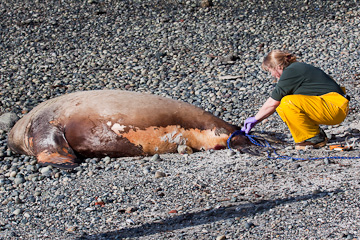
Additionally, it is believed that the second California sea lion necropsied late yesterday afternoon likely died from a bullet, but test results have not yet been completed to confirm this suspicion.
4 dead pinnipeds on West Seattle beaches
Feb/11/10 11:28 PM
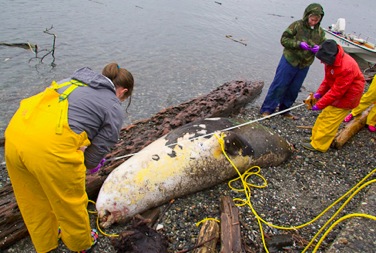
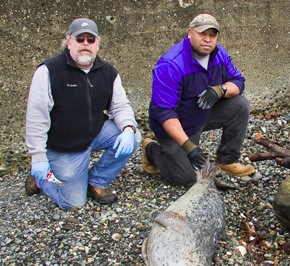
The body of the adult harbor seal was taken by the DFW for necropsy at their office. The decomposed body of a harbor seal on Constellation Park beach was buried by Parks earlier in the day. The bodies of the three marine mammals were secured with ropes by SS volunteers and Parks so that they would not go out with the tides before biologists could arrive on scene. Seal Sitters would like to thank Dan and Simi of Parks (shown at left with the harbor seal taken for necropsy) for their on-going help.
Please check back for updates as this story develops.
Spotted pup soaks up the sun
Feb/05/10 05:07 PM

Steller sea lion necropsy on private beach
Feb/02/10 10:49 PM
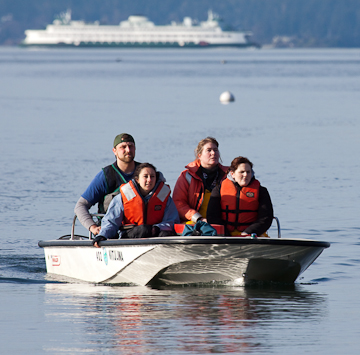
Stellers are the largest of all sea lions and can weigh up to 2500 pounds. Lighter in color than California sea lions, another distinguishing feature is a broadened head with less prominent bump on the forehead (sagittal crest). Their population numbers have plummeted in recent years and the western stock is on the endangered list. Read more about Steller sea lions here.
Billie's back!
Feb/02/10 10:36 PM
